Imagine your marketplace competing with giants like Airbnb, Etsy, and Fiverr on Google search. Tough, right? Well, not if you know how to play the SEO game. Marketplace SEO is how these platforms dominate search engines and drive millions of visitors every month — without relying solely on paid ads.
The good news? You can do it too.
This guide will walk you through everything you need to know about Marketplace SEO:
- How it works
- Why it’s different from regular SEO
- Proven strategies to help you rank higher, drive traffic, and boost conversions
We’ve built over 150+ React-based apps and optimized countless marketplace platforms for SEO, so we know what works. And now, we’re sharing these insights with you. Whether you run a small niche marketplace or a large-scale platform, this guide has everything you need to drive more traffic to your marketplace and increase sales.
What is Marketplace SEO (and Why is It Different from Regular SEO?)
What is Marketplace SEO?
Marketplace SEO is the process of optimizing a platform that connects buyers and sellers (like Etsy, Airbnb, or Fiverr) so that its content ranks higher in Google search results. The goal? To increase visibility, drive organic traffic, and attract more buyers and sellers.
Unlike regular SEO (which typically focuses on one business or brand), SEO for Marketplaces is more complex because:
- It includes thousands of pages (e.g., seller pages, product listings, category pages) that need to be optimized.
- It deals with dynamic content (pages that change often, like product search results or filterable pages).
- It requires management of user-generated content (like seller descriptions) to avoid duplicate content penalties.
Example:
When you Google “handmade jewelry,” you’ll likely see Etsy at the top of the page. Etsy doesn’t just rank for its homepage — it ranks for thousands of individual product listings. Why? Because they understand Marketplace SEO.
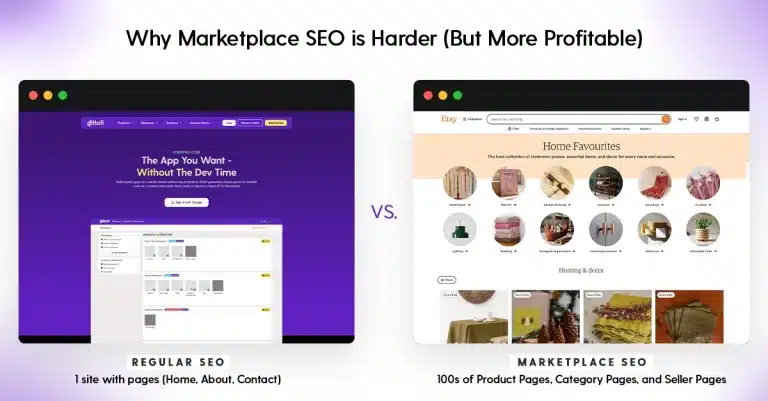
Why Marketplace SEO Matters for Growth & Revenue
Why does Marketplace SEO matter so much? Because it’s the #1 driver of traffic and sales for most platforms. If users can’t find your platform on Google, they won’t find your sellers — or your products.
Here’s why it matters:
Get More Free Traffic (and Reduce Paid Ad Dependence)
Google drives over 68% of all web traffic. If your marketplace ranks on Google’s Page 1, you get traffic for free — unlike paid ads, where you pay for every click.
Increase Visibility for Seller Pages & Listings
When product listings rank individually, sellers see better results, and they’ll be more inclined to list on your platform. More sellers = more products = more traffic.
Build Trust and Authority
Users trust search engines. Appearing on page #1 gives your marketplace instant credibility. Just look at how Etsy and Fiverr’s high search rankings make them the “go-to” platforms.
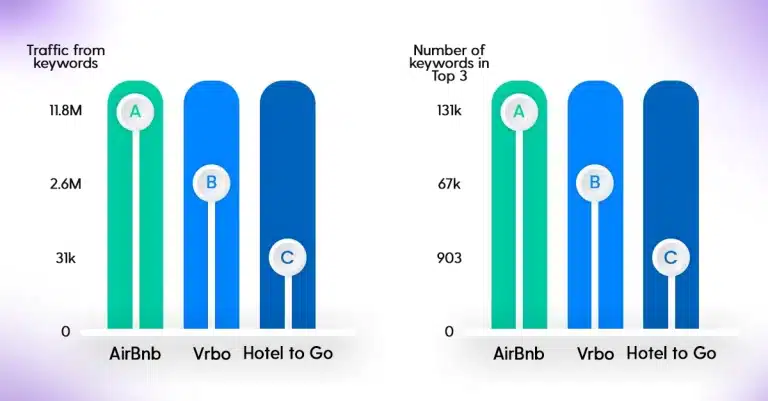
Key SEO Challenges for Marketplaces
Marketplaces face unique SEO challenges that regular websites don’t. If you don’t tackle these issues, you’ll end up with poor rankings, slow pages, and duplicate content that Google hates. Here are the top challenges:
1. Duplicate Content (Seller Pages, Listings, Categories)
Sellers often copy-paste product descriptions, which can create duplicate content. Google will only index one version and ignore the others.
Solution:
- Use canonical tags to tell Google which version to index.
- Allow sellers to create unique product descriptions.
2. Dynamic Content & Pagination
Marketplaces often have pages that update frequently (e.g., search results) or filterable content that creates “infinite pages.”
Solution:
- Use SSG (Static Site Generation) or server-side rendering (SSR) so search engines can index these pages.
- Create static URLs for filter-based pages.
3. User-Generated Content (Low-Quality Descriptions)
If sellers upload low-quality descriptions, it can harm your SEO. Google will treat it as “thin content” that offers no value.
Solution:
- Create a system for approving or rejecting seller-generated content.
- Allow rich descriptions, image alt tags, and FAQs for each seller page.
Every marketplace faces unique SEO hurdles — duplicate content, dynamic pages, and user-generated content are just tip of the iceberg. But here is the good news: every challenge is an opportunity to get ahead of your competition.
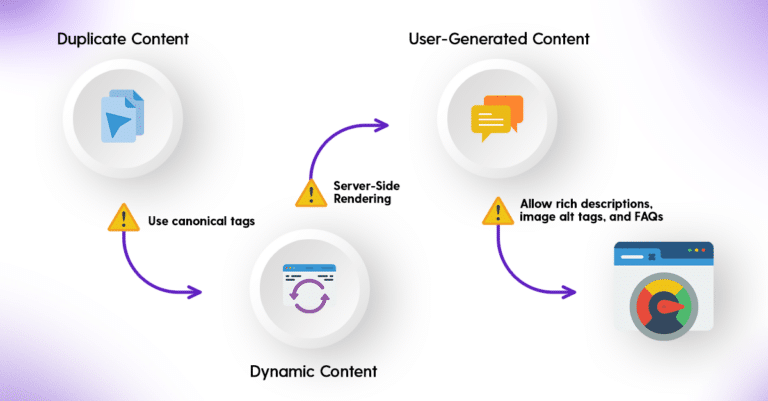
Proven SEO Strategies to Optimize Your Marketplace
Want to know the secret sauce behind the success of giants like Airbnb, Etsy, and Fiverr? It’s not luck — it’s strategy. These industry leaders have mastered marketplace SEO, and now it’s your turn.
Below, we break down their battle-tested SEO tactics so you can drive more traffic, rank higher on Google, and grow your marketplace like a pro. These aren’t generic tips — they’re real, actionable steps you can apply today.
Structure of the Listings Page: The Backbone of Marketplace SEO
Your listings page is the heart of your marketplace. It’s where users browse products, compare options, and, most importantly, convert. But it’s not just about design — the page structure plays a critical role in SEO. Without proper structure, Google may struggle to crawl and index your pages, which can tank your rankings.
Here’s how to structure a listings page for maximum SEO impact:
- SEO-Optimized Titles & H1 Tags
- Ensure your H1 clearly describes the page’s focus. For example, “Handmade Jewelry for Every Occasion” for a category page.
- Use a keyword-optimized page title like “Shop Handmade Jewelry Online – Unique Pieces Available.”
- Breadcrumb Navigation
- Breadcrumbs help Google understand the page hierarchy while improving user experience.
- Example: Home > Jewelry > Handmade Jewelry.
- Implement breadcrumb schema to boost your chances of being featured in rich results.
- Filterable, Crawlable URLs
- Make sure filters (like color, size, and price) generate clean, crawlable URLs. For example:
✅ /jewelry/handmade?price=low-high
❌ /jewelry?filter=price:low-high&sort=latest - Avoid infinite scrolling — use paginated URLs like /category/handmade-jewelry/page-2 for better SEO.
- Make sure filters (like color, size, and price) generate clean, crawlable URLs. For example:
- Product Listings with SEO-Optimized Content
- Include unique meta titles and meta descriptions for each product listing.
- Add short, descriptive product summaries with SEO-friendly H3 headings.
- Use call-to-action buttons like “View More” or “Buy Now” to improve engagement.
- Rich Snippets for Listings
- Use structured data (Schema Markup) to display product reviews, ratings, availability, and price in Google search results.
- This helps your listings stand out with review stars and price tags on SERPs, driving more clicks.
- User Reviews & Ratings
- Showcase reviews directly on the listings page. Reviews increase trust, engagement, and on-page time — all of which are factors that improve SEO.
- Use structured data for reviews to display star ratings directly in search results.
- Image SEO
- Use descriptive alt text for images (e.g., “Handmade gold necklace with gemstone”).
- Compress images to reduce load times. Faster pages = better SEO.
- Use WebP or Next.js Image Optimization to ensure images are modern, lightweight, and responsive.
- Internal Linking
- Link product listings to related category pages or similar products.
- Add internal links in descriptions, like “Looking for more handmade jewelry? Check out our best-selling earrings.”
- Canonical Tags (To Avoid Duplicate Content)
- If multiple URLs display the same content (e.g., filtered pages), use canonical tags to tell Google which page to index.
- For instance, if the same product exists at /category/handmade-jewelry?page=2 and /category/handmade-jewelry?price=low-high, set the canonical tag to /category/handmade-jewelry.
Optimize Product & Seller Pages
Once your listings page structure is set, it’s time to optimize your individual product and seller pages. Each of these pages is a chance to rank for long-tail keywords like “buy gold handmade jewelry online”.
Here’s how to optimize product pages:
- Custom Meta Titles & Descriptions: Write a unique meta title and description for every product to prevent duplicate content.
- SEO-Friendly URLs: Make sure URLs are clean and keyword-rich (e.g., /product/handmade-gold-ring instead of /product?id=1234).
- Rich Media: Use product images, 360° views, and demo videos to increase on-page engagement.
- FAQs on Product Pages: Answer buyer questions like “Is this handmade?” and “What’s the return policy?” to capture long-tail traffic.
- Use Trust Signals: Add review stars, trust badges, and customer testimonials to increase click-through rates from SERPs.
Boost Page Load Speeds (Core Web Vitals)
Site speed impacts both SEO and user experience. Slow pages = higher bounce rates.
How to improve load speed:
- Compress images and videos using WebP or Next.js Image Optimization.
- Minify CSS, JavaScript, and HTML using tools like Terser.
- Use lazy loading for off-screen images.
- Use a content delivery network (CDN) to cache images and static assets closer to the user.
- Monitor Core Web Vitals (LCP, CLS, and FID) using Google Lighthouse or GTmetrix.
Build a Solid Internal Linking Structure
Internal links help distribute “link equity” across your website. The more internal links a page has, the more value it has in Google’s eyes.
Internal linking tips for marketplaces:
- Link Listings to Categories: Every product listing should link back to its category (e.g., “More in Handmade Jewelry”).
- Use Breadcrumb Navigation: Breadcrumbs create a natural hierarchy and help users navigate.
- Cross-Link Related Products: At the bottom of product pages, show “You May Also Like” product suggestions to encourage more clicks.
- Link to Seller Pages: Create links to seller pages (e.g., “More products by [Seller Name]”) to give seller pages more link juice.
Create Dedicated Category Pages
Category pages are an SEO goldmine. Instead of focusing solely on product pages, create category pages that rank for high-volume terms like “Handmade Jewelry” or “Etsy Gold Rings”.
Category Page SEO Tips:
- Use an optimized H1 like “Shop Handmade Jewelry”.
- Write 150–200 words of SEO-friendly content at the top of the page (but keep it user-friendly).
- Add FAQs with collapsible answers (schema-friendly).
- Include internal links to popular products.
- Use a clean, simple URL structure (e.g., /category/handmade-jewelry/ instead of /category?id=789).
Use Blog Content to Drive Marketplace Traffic
Blog-driven SEO is a powerful way to funnel high-intent traffic to your marketplace. By writing content that targets “how-to” and “best of” queries, you can attract users searching for solutions—and guide them to your marketplace pages.
Blog SEO Tips:
- Target long-tail keywords like “Best Road Trips in California” or “How to Rent a Car Without Hidden Fees”.
- Internally link to category, product, or seller pages from your blog (e.g., “Explore car rentals in California”).
- Add a CTA like “Book your ride today” to boost clicks to key pages.
- Use blog content to rank for informational keywords that product pages wouldn’t rank for.
With the right strategy, your blog can become a major traffic driver, boosting marketplace visibility, brand authority, and SEO rankings.
Use Rich Snippets (Structured Data)
If you want Google to display reviews, prices, or availability in search results, you need rich snippets.
How to Use Rich Snippets for Marketplaces:
- Use Product Schema for product pages (show price, reviews, and availability).
- Use Breadcrumb Schema for listings pages (so breadcrumbs appear in search).
- Add FAQ Schema to seller pages or category pages to boost visibility.
SEO Tools for Marketplaces
Optimizing a marketplace without the right tools is like navigating a maze blindfolded. The good news? There are plenty of tools to simplify the process. From crawling your site for errors to analyzing keyword rankings, these tools will help you fine-tune your SEO strategy for maximum impact.
Here’s a breakdown of the best SEO tools for marketplaces and how to use them effectively.
1. Google Search Console
Purpose: Track indexing, coverage, and search performance
Why You Need It:
Google Search Console is a free, must-have tool for any marketplace. It helps you identify which of your marketplace pages are indexed by Google and flags issues with duplicate content, mobile usability, and crawl errors.
How to Use It:
- Index Coverage Report: Check which marketplace pages are indexed, and identify any that are excluded or have errors.
- Performance Report: See which product pages get the most clicks, impressions, and average position in Google SERPs.
- Submit Sitemaps: Upload your sitemap to ensure Google crawls all pages of your marketplace.
Pro Tip: Focus on fixing “Excluded” pages, as they’re often a sign of technical issues like duplicate content or crawl errors.
2. Screaming Frog
Purpose: Crawl your marketplace site for SEO issues
Why You Need It:
Screaming Frog acts as a mini Google crawler, scanning your site to uncover errors like duplicate content, broken links, missing meta descriptions, and more. For a large marketplace with thousands of seller pages and product listings, Screaming Frog is an essential tool.
How to Use It:
- Run a full site crawl and review the duplicate content report.
- Identify missing title tags and meta descriptions on product and category pages.
- Check for broken links and redirects that could hurt your user experience and SEO.
Pro Tip: Use Screaming Frog to crawl each language/region subdomain if your marketplace targets multiple locations (like /us, /uk, /de, etc.).
3. SEMrush / Ahrefs
Purpose: Keyword research, backlink analysis, and rank tracking
Why You Need It:
Want to outrank your competitors? Tools like SEMrush and Ahrefs give you competitive insights on what keywords your competitors rank for, who links to them, and how you can outdo them.
How to Use It:
- Find Competitor Keywords: See which keywords your competitors rank for and create better content for those queries.
- Backlink Analysis: Identify high-quality sites linking to your competitors and pitch them to link to your marketplace too.
- Content Gap Analysis: Identify which keywords your competitors rank for that you don’t, and create new product/category pages around them.
Pro Tip: Use Ahrefs’ Content Gap Tool to discover what keywords your competitors rank for that you’re missing out on.
4. GTmetrix
Purpose: Page speed optimization (Core Web Vitals)
Why You Need It:
Page load speed directly impacts SEO rankings and conversions. GTmetrix analyzes your page’s speed and shows you how to optimize it. Since many marketplaces rely on large images and scripts for filtering products, GTmetrix can help you fix Core Web Vitals issues.
How to Use It:
- Check your Largest Contentful Paint (LCP) and Cumulative Layout Shift (CLS) scores.
- Compress large images to reduce file size and enable lazy loading.
- Identify which JavaScript files are slowing down your site and consider using tree-shaking.
Pro Tip: Reduce Total Blocking Time (TBT) by deferring non-critical JavaScript.
5. Dittofi (for Hybrid No-Code Marketplace SEO)
Purpose: Build SEO-optimized hybrid no-code marketplaces
Why You Need It:
If you’re building a marketplace without a developer, Dittofi is a win. It allows you to create a fully SEO-optimized marketplace with no coding required. This means you can create unique meta tags, structured data, and clean URLs for every product and seller page.
How to Use It:
- Use Dittofi’s SEO-friendly templates for pre-built, optimized page structures.
- Set up custom Hreflang tags for multilingual marketplaces.
- Customize meta descriptions, URLs, and titles for product pages.
Pro Tip: Many traditional no-code platforms struggle with SEO for dynamic pages. Dittofi, however, is designed to support structured data and SSR for better indexing.
With the right tools, optimizing your marketplace for SEO becomes less of a guessing game and more of a data-driven strategy. From keyword research to technical audits, these tools help you track performance, uncover opportunities, and stay ahead of the competition.
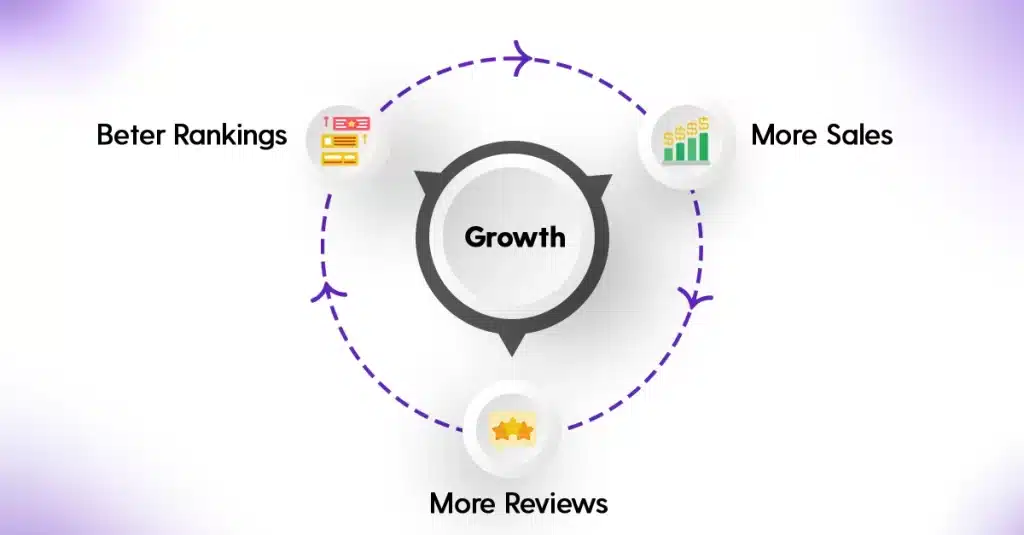
Real-World Marketplace SEO Success Stories
Nothing drives a point home like real-world results. These successful companies have mastered Marketplace SEO and achieved outstanding growth by using the tactics we’ve outlined.
1. Airbnb: Ranking for Localized Search Queries
Challenge: How do you rank for location-based searches like “vacation rentals in Paris”?
Solution: Airbnb uses server-side rendering (SSR) to create location-specific pages that rank for keywords like “Vacation Rentals in Paris” or “Beach Homes in Florida.” They also use structured data (schema) to display reviews, availability, and prices directly in Google SERPs.
Key Takeaways:
- Use static, localized URLs for each location (e.g., /paris/vacation-rentals) to rank for location-based keywords.
- Use structured data for reviews, star ratings, and availability on search results.
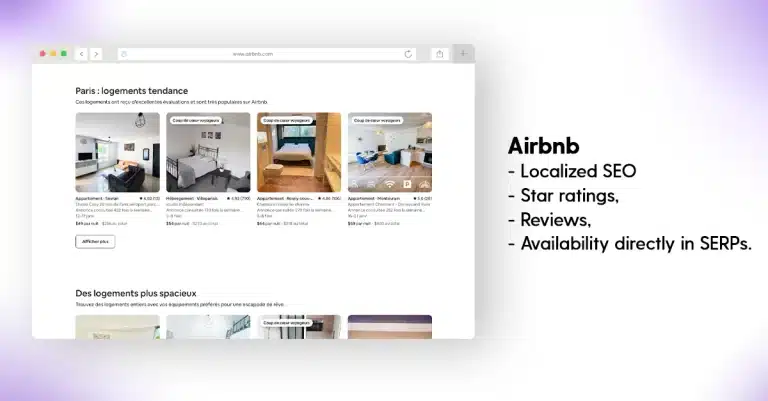
2. Etsy: Dominating Search for Individual Product Pages
Challenge: How do you make every product listing rank individually on Google?
Solution: Etsy optimizes each product page with unique meta titles, descriptions, and image alt text. They also allow sellers to customize descriptions and use canonical tags to avoid duplicate content.
Key Takeaways:
- Allow product pages to have unique metadata and titles (no duplicate content).
- Use canonical tags for similar product pages to avoid duplication penalties.
- Empower sellers to write optimized product descriptions.
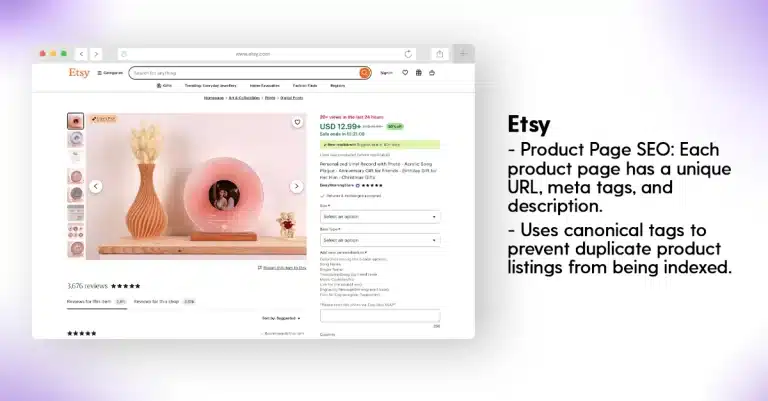
3. Fiverr: Ranking for Service Categories and Seller Pages
Challenge: How do you rank for niche categories like “Logo Design” or “SEO Services”?
Solution: Fiverr creates category landing pages that link to seller profiles and services. They use H1 tags, optimized headings, and SEO-friendly breadcrumbs to help Google understand the site’s structure.
Key Takeaways:
- Create dedicated category pages that act as SEO hubs.
- Ensure that each service page has a clear, SEO-friendly URL and a unique description.
- Use internal links to connect seller pages, categories, and products.
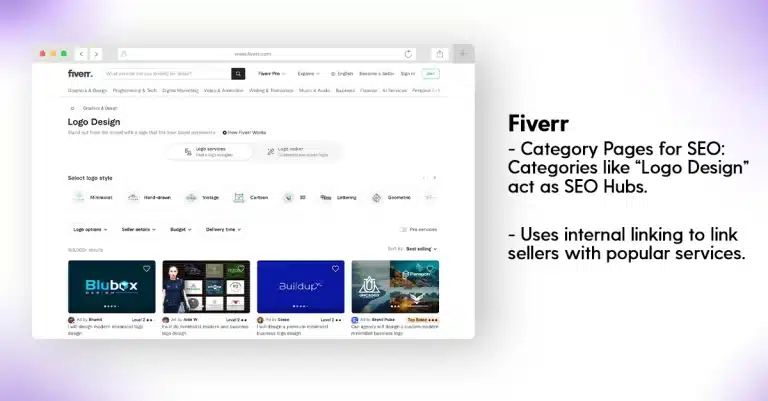
Ready to Dominate the Marketplace SEO Game? Here’s Your Next Move!
By now, you’ve learned the essential strategies, tools, and techniques to supercharge your marketplace SEO. From optimizing your product pages to leveraging backlinks and mastering technical SEO, you have all the ingredients for success.
But remember — SEO isn’t a “set it and forget it” task. It requires continuous improvement, regular audits, and staying ahead of search engine updates. Companies like Airbnb didn’t dominate overnight. They tested, adapted, and refined their strategies over time — and now, you can too.
So, what’s your next move? Put these strategies into action. Start small by optimizing product pages, experiment with link-building, and don’t forget to track your progress with the tools we’ve shared. Each step you take brings you closer to increased visibility, higher traffic, and better conversion rates.
If you’re ready to turn your marketplace into an unstoppable SEO machine, it’s time to get started!
Optimize Your Marketplace in Minutes!
Leverage the techniques top platforms use to rank on Google’s Page 1. Your marketplace deserves the spotlight—start optimizing today.

